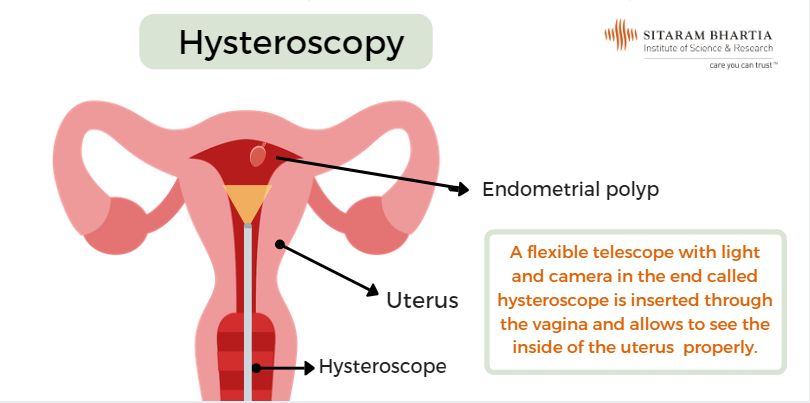Hysteroscopy is a procedure which allows the doctor to look inside a woman’s uterus and examine it along with the cervix (mouth of the uterus). This helps in diagnosing and treating many ailments of the uterus.
Suhani Bhatnagar, 27, was a little apprehensive when she was suggested a hysteroscopy by Dr. Namrita Gurpal Singh Sandhu, Consultant, Obstetrics and Gynecology at Sitaram Bhartia Hospital in South Delhi.
Suhani had come for medical help to Dr. Namrita Gurpal Singh Sandhu when she was having irregular periods and when the pain during her periods (dysmenorrhea) became so extreme that it often forced her to miss work.
Dr. Namrita Gurpal Singh Sandhu suggested an ultrasound which revealed an endometrial polyp (non-cancerous growth found inside the uterus). In the next visit, she was told to undergo a hysteroscopy to remove that polyp.
But since it was the first time Suhani actually had to go through a medical procedure such as this one, there were thousands of doubts flooding her mind. She proceeded to discuss it with her doctor.
More about hysteroscopy
“What is a hysteroscopy and when is it done?” asked Suhani who was quite unfamiliar with the procedure.
Hysteroscopy is a safe and minimally-invasive procedure which allows the doctor to visualise the inside of the uterine cavity to investigate symptoms like abnormal bleeding (diagnostic hysteroscopy) or treat any underlying pathological conditions (operative hysteroscopy).
“Hysteroscopy is an efficient way to remove uterine polyps, small fibroids etc. without making any cuts to the body,” Dr. Namrita Gurpal Singh Sandhu said.
Suhani was a bit relieved to hear this but she was still anxious about how it is carried out.
Hysteroscopy Procedure Explained
“During a hysteroscopy, a narrow telescope called a hysteroscope is used which has a light and camera attached at the end. This instrument is inserted into the womb through the vagina and cervix. Once the hysteroscopy reaches the womb, it sends images on our monitor and we are able to see the inside of the uterus clearly,” Dr. Namrita Gurpal Singh Sandhu said while showing pictures of the procedure to Suhani so that she feels more accustomed to the idea.
“When the polyp is spotted successfully, an electrosurgical wire loop is inserted through the hysteroscope. This allows us to cut the polyp from its attachment point and take it out. This procedure is known as hysteroscopic polypectomy.”

Is a hysteroscopy painful?
This was the very next question Suhani asked her doctor after fully understanding the procedure.
In case of a diagnostic hysteroscopy (if done as an outpatient procedure), some women might experience mild pain and discomfort.
“Since you are going to go through hysteroscopic polypectomy, we will administer general anaesthesia in the operation theatre to avoid any discomfort.”
Hysteroscopy Indications
“What other conditions are there which a hysteroscopy can diagnose and treat?” Suhani asked out of curiosity.
Apart from the removal of endometrial polyps, hysteroscopy is really helpful in treating conditions like:
- Fibroids which are non-cancerous growths found in the uterus
- Adhesions which are a collection of scar tissues that can form in the uterus and affect the menstrual flow and fertility
- Uterine septums which are malformations of uterus present since birth
“When it comes to diagnosis, this procedure helps us in detecting the causes of some common symptoms women experience like heavy or painful menstrual bleeding, unusual bleeding, postmenopausal bleeding, pelvic pain, repeated miscarriages or failure in getting pregnant after several tries.”
Suhani listened to all of it carefully and continued to clear her doubts about the procedure.
How long does it take to get over a hysteroscopy?
Hysteroscopy is carried out as an outpatient procedure and usually takes up to 10 minutes if its only for diagnostic purposes and up to 30 minutes if the condition is operated upon during the procedure itself.
“Hysteroscopic polypectomy takes about 15 to 20 minutes only,” said Dr. Namrita Gurpal Singh Sandhu.
Suhani was glad to hear that. She went forward to schedule her procedure with Dr. Namrita Gurpal Singh Sandhu.
“It is best to schedule a hysteroscopy within the week after periods before ovulation starts. This allows us to get the best view of the uterus.”
Suhani discussed her menstrual cycle with the doctor and they finalised a date for the procedure.
Preparing for hysteroscopy – What to do?
Dr. Namrita Gurpal Singh Sandhu asked Suhani to get a few blood tests done to ensure that she is good to go for the procedure.
One last thing Suhani was concerned about was the recovery after the procedure. Since she was in the middle of a big project at work, it was difficult for her to take prolonged leaves.
Hysteroscopy recovery – What can I expect after a hysteroscopy?
Dr. Namrita Gurpal Singh Sandhu assured Suhani that she will be able to leave for home the same day after the procedure.
“Since hysteroscopy doesn’t involve any cuts, the recovery time is much faster. You might experience some pain and witness mild bleeding for 4 to 5 days but that is normal. A few days rest will be enough to get you back to your daily routine.”
Suhani was satisfied with the discussion she had with her doctor which helped her to remain calm on the day of the procedure.
Dr. Namrita Gurpal Singh Sandhu was successfully able to remove the uterine polyp through hysteroscopy. It was sent to the lab for analysis to make sure it doesn’t have any cancerous cells.
Thankfully, the polyp turned out to be benign.
Suhani was able to get back to work a day after the procedure and was thankful to Dr. Namrita Gurpal Singh Sandhu for her guidance and support.
 Medically Reviewed by Dr. Namrita Gurpal Singh Sandhu
Medically Reviewed by Dr. Namrita Gurpal Singh Sandhu
MBBS, Government Medical College & Hospital, Chandigarh, India (2005) DNB, National Board of Examinations (2012), MRCOG (Part One), Royal College of Obstetricians and Gynaecologists (2015), Diploma in Gynecological Laproscopy, Hysteroscopy and Urogynecology, Kiehls school, Germany (2019)
Experience: 10+ years

